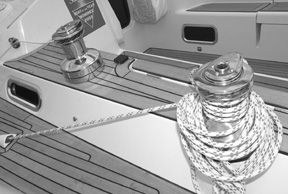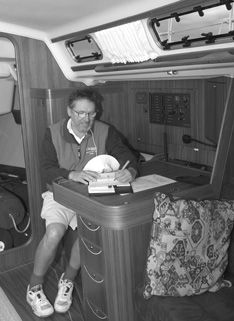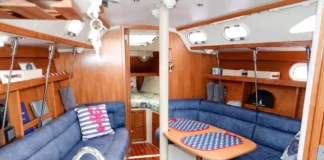A small blip on the radar screen of the U.S. sailing community, X-Yachts of Denmark celebrated its 25th anniversary in 2004 by totally revamping its product line. The company was formed in 1979 by owner/managers Niels Jeppeson, brother Lars, and Birger Hansen.
Niels Jeppesen established a reputation as the designer of high-performance sailing yachts prior to forming the company. In the ’80s, he was known in racing circles as the designer of successful IOR, IMS, and other rule–based hotrods. The firm’s production yachts enjoy the same reputation for performance, along with the addition of comfortable accommodations, and quality construction methods. The first production model was the 412, which was followed by a bevy of boats ranging in size from 32 to 61 feet, though X-Yachts primary market is 32 to 44-footers. In 2000, the company introduced the IMX 40, an IMS racer that accumulated an impressive number of wins on the circuits in Europe. Historically, X-Yachts has built 250 to 300 boats per year.
In 2004, the company revised its entire product line. Michael Frank, the U.S. importer of X-Yachts, said: “The change was prompted by the success of the X-43, a performance cruiser introduced in 2003. That yacht incorporated a number of evolutionary design features and deck arrangements borrowed from predecessor models,” a more plumb bow and narrower shape forward, for instance, coupled with proportionally longer waterline length. Frank said the new models reflect evolutionary updates in styling, interior layouts, cabinetry, deck layouts, and new keel and rudder profiles designed to enhance performance.

As a consequence, potential buyers began deferring purchases in anticipation of changes to other models, so the company accelerated the design process, eliminated some outdated models, and introduced new 46, 40, and 37 foot models, all of which were instant successes. Back orders now extend into 2005.
The company has been sufficiently successful in Europe, so it felt no compulsion about a major marketing push in the U.S. That situation is changing. X-Yachts has a small but loyal following on these shores, and Frank is adding to a network of dealerships in Connecticut, Annapolis, San Francisco, and Seattle in the face of the arrival of ETAP, Elan, Hanse, and other European builders making appearances stateside.
Design
Except for three bootstripes at the waterline, the appearance of the X–40 seems like many of her competitors. Her high-aspect sail plan is accented by a three-quarter fractional rig and a boom that extends to the aft end of the cockpit, so she looks more traditional than new models with tall rigs and short booms. In profile, her bow is near-plumb, her sheer almost level, and her stern reversed. Her 12′ 5″ beam is so proportionate as to be almost unnoticeable, though it produces wide working surfaces under sail.
Her cabintop flows smoothly aft, the only interruption being a tiny elevation created by an instrument pod on the companionway hatch. Four long, slim ports help make her profile attractive.
On Deck
The arrangement of deck hardware and lines includes two entirely new features. First: the mainsheet design (referred to as a “German mainsheet system” by the manufacturer) consists of four ball-bearing blocks for mainsheet and traveller controls, so trimming the sail does not require the strength of a weightlifter. The unique aspect is that the mainsail is trimmed from the cockpit coaming, rather than from the pit or atop the companionway. The mainsheet leads from the traveller up to the boom and then forward from the end of the boom to the mast where it then drops down to the deck on either side and disappears below the deck in a run near the shrouds. It reappears on either side of the cockpit at Anderson 40 winches located just aft of the primaries. The result is that there are fewer bodies and strings in the cockpit and the helmsman or trimmer can trim the mainsheet and traveler simultaneously, and ease the mainsheet quickly in a puff, without interfering with the headsail trimmer. These are all significant advantages, even on a cruising boat.
Load-adjustable Fredericksen genoa cars that allow fine-tuning the headsail without leaving the cockpit are standard equipment on the X-40. One option on our test boat was package of electric primary winches ($7,300) that replaced the two-speed Andersen 46 self-tailers that come as standard equipment.
For cruisers, a dodger lives on the cabintop in a fiberglass trough so it is nearly flush to the deck when not in use. An easily removable zippered synthetic leather cover protects it from the elements. When elevated, the height of the dodger is low enough for a 5′ 10″ driver to see over the structure, allowing the helmsman a 360-degree view while the crew is protected from the elements.
The company installs a tapered, triple-spreader, anodized aluminium mast that was specifically designed for this boat, rather than specifying a shorter version of spars used on other models. The mast-collar is integrated in the fiberglass deck structure, and mast blocks are mounted and secured in the deck structure. Shrouds are deadended in tip cups connected to a stainless steel tie rod under the deck that is connected to side stringers in the hull to produce a stable platform for the rig.
Standing and running rigging is higher quality than found on most production cruising yachts. The standing rigging is discontinuous stainless steel rod with rod turnbuckles. And main, genoa, and spinnaker halyards all are Spectra, producing strength that resists stretching. Halyards, reef lines, cunningham, vang and outhaul are led to two, five-part Spinlock XCS winch stoppers located on the cabintop.
The teak toerail is 1 1/4″ high from bow to mast, then diminishes to a height of 3/4″ from the mast to the stern. That is lower than seen on many oceangoing yachts, but it’s coupled with double lifelines run through eight stainless-steel stanchions, tall enough to meet EC and ORC safety requirements. Stainless steel mooring cleats are located fore and aft; additional cleats are an option.
With 9′ 1″ of fore and aft space on the cockpit centerline, and the wheel well aft at the stern, the cockpit has room for 6 crewmembers to lounge, and for a racing crew of 6 to 8 to maneuver. The helmsmen sits aft of or beside a 66″ diameter, leather-covered wheel attached to a rack-and-pinion steering system that we found quite responsive regardless of the point of sail.
Two shallow storage lockers are located in the center of the cockpit sole and two on the corners are adequate for storing small items and propane tanks. Passagemakers planning an extended cruise will be required to plan efficiently for the storage of additional gear.
The smallest of three portlights on the cabinside measures 17″ x 7″, the largest 27″ x 7″. Those, coupled with two portlights in the aft cabins and 20″ square hatches in the main saloon and forward stateroom, mean that this boat has adequate light and ventilation except in the steamiest climates. Hatches in the saloon and forward cabin are fitted with Oceanair units containing both flyscreens and blinds.
Bottom Line: This boat is well equipped with durable gear and deck hardware, and displays a few new wrinkles that we might like to see on other boats in this genre.
Accommodations
Scandinavian boats are known for their woody interiors, quality of workmanship, and finishes, and the X-40 is no exception. And the spaces belowdecks are well organized for cruising or daysailing.
Interior lighting is provided by 11 halogen fixtures and two dome spotlights cleverly integrated and almost out of sight in the liner. An additional fixture is located at the chart table.
The main saloon on our test boat was finished with teak veneers that are hand polished to a satin finish and teak laminate floorboards, all accented by a bright white ceiling and overhead that reflect light to create a feeling of spaciousness.
The length of the main saloon from the foot of the companionway to the main bulkhead is 11′ 2″. With 6′ 3″ of headroom and settees that measure 6′ 7″, a crew of six to eight will not feel cramped.
Two layouts are offered, both with the galley to starboard opposite the nav station, and dining area to starboard. Our test boat was fitted with two staterooms aft and the skipper’s quarters and head forward; an alternative is a two-stateroom, two-head version.

With one exception, both models provide comfortable accommodations. However, as with the X-332-Sport that we tested prior to its being replaced by an as yet unbuilt 35-footer, space in the aft stateroom (where the head is located on the X-332) is compromised by the intrusion of the cockpit lockers. As a result, though the forward sections of the staterooms have more than 6′ 4″ of headroom and room to dress, the space above the berth is low enough to be a headknocker.
Beyond that, the layout offers diners room to sup on a trapezoid shaped, leafed table measuring 47″ x 35″ fitted with a built-in bottle locker. Outboard on both sides of the saloon are enclosed cabinets designed for the storage of drinking glasses and the like. The table is positioned far enough to starboard to allow passage on the centerline with the leaf down. Diners seated to port can use its surface simultaneously—a good arrangement.
The nav station offers a seat facing forward, under which is a storage area, chart table, large electric panel and bulkhead with room for VHF, SSB radio, and other electronics. The papers and tools that inevitably accumulate at a nav station may be stored in the 2′ 3″ x 3′ 1″ table, outboard in an open cabinet, and in three drawers below the table, some of which will probably be reallocated for galley tools.
The galley is a typical L-shaped space with a four-cubic-foot, top-opening icebox (cooled by a Coolmatic 85 refrigerator unit) incorporated here. Storage is on shelves and in cabinets enclosed by Plexiglas sliding doors, and 10″-wide drawers that are ample for plates, cutlery, pots and pans. However, most dry goods will have to be housed in other areas. The twin stainless steel sinks are a plus, as are granite countertops measuring 20″ x 26″ and 14″ x 20″ that provide a chef with ample room to operate. Standard equipment includes a gimballed, stainless steel, Techimpex two-burner stove with oven. The freshwater system consists of hot and cold pressurized water with approximately 46 gallons of fresh water held in a plastic tank. Mixing water taps are fitted in the galley and head.
As with the deck arrangement, we found two subtle features adding to the vessel’s utility, of which other boat manufacturers could take note: The skipper’s quarters are forward in a stateroom surrounded by wood finished as nicely as the main saloon. Lockers and lounging chairs are located port and starboard, aft of a V-berth that measures 6′ 4″ on the centerline. Reading lights are located at pillow height on both sides of the hull. Space for storing bedding is located underneath the berth.
Unlike builders who simply tack open shelves to the hull sides, X-Yachts has cleverly attached storage cabinets running the entire length of the stateroom, a godsend for distance cruisers.
In the three-cabin version, each aft cabin has a double berth measuring 7′ 0″ on centerline; the staterooms are separated by a fixed bulkhead. Interestingly, other builders accomplish the split by inserting removable partitions to facilitate the removal of a box covering the aft end of the engine. X-Yachts takes the opposite approach, with a better result; a two-piece engine cover is easier to remove, and takes up less space in the compartment when removed, and the fixed bulkhead produces a better sound barrier between the staterooms.
The aft staterooms are also furnished with deep shelves running along the hull that are significantly wider and deeper than those seen on most boats, where they often seem to be cosmetic afterthoughts rather than functional units, unless enclosed by long nets.
The head is too small, but can be accessed from the main saloon and the forward stateroom. Measuring only 3′ 3″ x 3′, it is not much wider than the shoulders on a typical 6′ adult, but headroom is 6′ 1″.
Bottom Line: Considering the living spaces, their arrangement and apportionment, and the fit and finish of the interior, the X-40 lives up to the company’s reputation for producing a nicely finished product. The clever use of hull space for storage is a real plus, as is the arrangement of the engine box; but, a larger head would be a real plus for a 6′ 4″ full-bodied crew.
Construction
X-Yachts has a history of building solid vessels designed to be used in heavy seas, or abused on the racecourse. Though the company is now building for a cruising market, the standard remains the same, as X-Yachts’ products are built in accordance with the European CE-Certification and meet the requirements of the CE-directive 94/25/CE for category A (ocean) recreational craft. Among the requirements are that a yacht must be designed to operate in waves up to 21 feet and winds of Beaufort force 10 (45 – 55 kph), or less. The company says the yachts fulfill the standard of the ABS Hull Certification that includes the hull, deck, keel, keel attachment to the hull, rudder, rudderstock and bearings, as well as bulkheads and frames.
Hull and deck are laminated in a sandwich construction consisting of isophthalic polyester resins and biaxial E-glass fabric surrounding a compressed Divinycell® core. Additional reinforcements of biaxial E-glass are laid in high stress areas around the keel and rudder. The hull-deck joint is secured with polyester resin and through-bolted.
Unlike most production builders that construct a grid support system of fiberglass, X-Yachts installs a steel frame constructed of hot-galvanized steel that absorbs the loads from keel, mast, and rig. A well-conceived addition is a hoist attachment point bedded in the grid that takes the guesswork out of hoisting the boat. Structural bulkheads are constructed of marine plywood in thicknesses of 1/3″ to 7/8″ that are bonded to both hull and deck.
The keel is a cast iron fin with a lead bulb enclosed in a layer of GRP; X-Yachts’ keels are faired with a polyester compound before leaving the factory, a contributor to balance and performance.
The rudder blade is constructed of biaxial fiberglass and Divinycell®. The rudderstock is solid aluminium, tapered at the ends to reduce weight, but strengthened by three welded wings. Upper rudder bearings are rollers, lowers are self-aligning.
The Yanmar 40 hp diesel engine is mounted on rubber shock absorbers; a 16″ folding propeller is standard. The engine panel, located in the cockpit, is recessed and enclosed in Plexiglas; standard gauges are tachometer, oil pressure alarm, water temperature, and hour meter. The X-40 carries approximately 20 gallons of fuel in an aluminium tank.
Price
The company’s products are priced at the high end of the market and, according to Frank, “have the quality and value of J/Boats and Sabre Yachts,” which are considered to be among the best production boats manufactured in the U.S.
The base price for the X-40 with a 2 or 3 cabin layout is $287,100. However, a fully equipped boat with instruments and sails will carry a sticker price of $315,000 to $325,000, FOB the East Coast.
In lieu of the standard 6′ 5″ keel, a 5′ 6″ shoal draft alternative is available (for an additional $2,275), or you can opt for a 7′ 6″ deep draft keel (for $4,725).

Performance
Based on a test sail of the X-332 Sport that took place shortly before the company discontinued production of that model, we had great expectations for the X-40. Despite sailing on the Chesapeake Bay in less than ideal conditions, she performed as well as advertised. For openers, we sailed with a borrowed mainsail that was 18″ short on the hoist and 12″ short on the foot. Thankfully, our test boat carried the standard 135% jib.
Sailing on flat water with the windspeed ranging from 0 to 6 knots, she managed to produce 5 knots of boatspeed on the GPS while pointing to within 35 degrees of the apparent wind, and duplicated that performance when we eased sheets. Though she had no stores aboard, we sailed with a crew of roughly 2,000 pounds. Few production boats in this size range will duplicate that performance. We consider this a fair test of her ultimate performance, since most modern boats will sail to their designed hull speed in 10 knots of wind, and can be reefed when the wind pipes up.
Under power, the X-40 motors at 7 knots at 2,300 rpm, and 8 knots at 3/4 throttle, and turns smartly in her own length. We were troubled by the sound of an electric motor after turning off the ignition until we learned that standard equipment includes a bilge blower on a timer that operates for two minutes after depowering—an excellent idea that’s likely borrowed from the powerboat industry.
Conclusions
With more than two decades of experience, and a Scandinavian boatbuilding heritage, X-Yachts enjoys an excellent reputation in Europe that may be duplicated on these shores if Frank is able to build a nationwide distribution system.
This boat’s pluses include a well-conceived and equipped deck layout, a sensibly arranged interior down below with high-quality finish and joinery; and a hull shape and appendages that will produce fast bluewater passages. Though there are few, the negatives include a confining head and a big sticker price; the latter, admittedly, would likely be offset by a strong trade-in value.
If we were in the market for a new 40-foot sloop, we’d give this boat a close look and consider it a legitimate performance cruiser, and—for the competitive skipper—a viable candidate for buoy or distance racing.
Contact – X-Yachts USA, 203/353-8118, www.x-yachts.com.
Also With This Article
“Critics Corner: X-40”







































